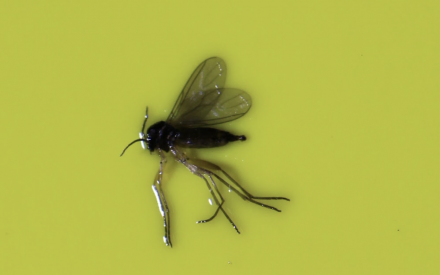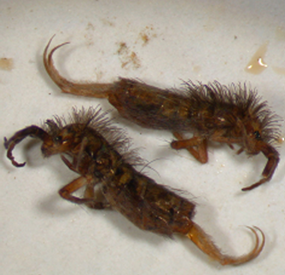
Karen Delahaut, formerly UW-Madison Fresh Market Vegetable Program
Revised: 4/26/2004
Item number: XHT1129
Mealybugs are slow-moving, small, oval insects that are covered with a white, cottony wax. They are tropical insects that are typically only found on perennial foliage plants, and rarely on flowering or bedding plants. They can infest all plant parts including the roots. Mealybugs are related to scales. The citrus mealybug (Planococcus citri) is the most common greenhouse species and is the most damaging.
Appearance: Mealybugs are pink, soft-bodied insects that range in size from 1/20 to 1/5 of an inch. They are somewhat elongated and segmented and have waxy filaments extending from their hind end, giving the appearance of a tail. They are covered with a white or grey cottony wax. Because of their appearance, mealybugs may be confused for cottony cushion scale or wooly aphids. Unlike their close relatives the scales, mealybugs retain their legs throughout their life.
Symptoms and Effects: Mealybugs feed at stem tips, and where the leaf meets the stem. The citrus mealybug is more common on tropical foliage plants or soft-stemmed, succulent plants such as coleus, fuchsia, and cactus. Long-tailed mealybugs prefer dracaena over other species. Symptoms of mealybug feeding include stunting, chlorosis, defoliation, and wilting. Because mealybugs feed on sugary plant juices (photosynthates), their waste contains a high sugar content and is referred to as honeydew. Honeydew is sticky and can support the growth of sooty mold fungi, which are not harmful to the plant, but if present in high enough concentrations, can impair photosynthesis in the leaves. Citrus mealybugs cause additional problems by injecting a toxin as they feed.
Life Cycle: Mealybugs lay up to 600 small, yellow eggs in a protective cottony mass. Egg-laying is temperature dependent with fewer eggs laid at high temperatures. Long-tailed mealybugs don’t lay eggs, but bear live young in a manner similar to aphids. After laying eggs over a period of five to 10 days, the female dies. Young female mealybugs go through three instars (stages) and are mobile their entire lives. Immature males (nymphs) settle and spin a white, waxy cocoon. Adult males are tiny and winged, but rarely seen, and only live a few days. One generation develops every one to three months depending on temperature.
Scouting Suggestions: Visually inspect the leaf whorls of susceptible plants. Long-tailed mealybugs can often be found in whorls. Examine any white mass carefully to determine whether it is a mealybug, a mealybug egg mass, or the larval stage of the beneficial mealybug destroyer (see below). Yellowed or wilted foliage may indicate an underground mealybug infestation. This is particularly common in African violets. Check for white cottony masses around drainage holes to determine whether a closer inspection of the roots is necessary.
Control:
Non-Chemical: The best mealybug management is avoidance. All new plant material should be inspected upon arrival and any infested plants should be returned to the supplier. Destroy heavily infested greenhouse plants as they will be difficult, if not impossible, and very costly to clean up. Remove any excess soil and compost piles from the growing area to prevent an alternative infestation site.
Mealybug destroyers are a type of beetle that can be very effective in controlling mealybug populations in some situations. However, for this technique to be effective, you must be willing to tolerate a low level infestation of both pests and beneficial insects on your plants.
For more information on biological control, refer to NCR publication 581 Biological Control of Insects and Other Pests of Greenhouse Crops.
Chemical: There are several insecticides available for control of mealybugs. Refer to UW-Extension publication A3744 “Insect Pest Management for Greenhouses” for a complete listing of available products. Chemical control will be difficult because of the protective nature of the wax covering the insects. Contact sprays using insecticidal soaps are affective against the mealybug crawler stage provided coverage is thorough. Use insect growth regulators when beneficial insects are present. You will need two to three treatments at 10-14 day intervals to get good control, as the eggs and adult stages are protected from most insecticides.
For more information on mealybugs: See UW-Extension Bulletin Insect Pest Management For Greenhouses.
Download Article





 Euonymus Scale
Euonymus Scale Scales
Scales Fungus Gnats and Shore Flies in Greenhouses
Fungus Gnats and Shore Flies in Greenhouses Springtails
Springtails


